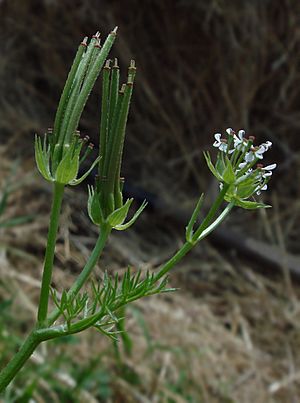Shepherd's-needle facts for kids
Quick facts for kids Shepherd's-needle |
|
|---|---|
 |
|
| Fruits and flowers | |
| Scientific classification | |
| Genus: |
Scandix
|
| Species: |
pecten-veneris
|
Scandix pecten-veneris is a plant known by many names, like shepherd's-needle, Venus' comb, and Stork's needle. It belongs to the Apiaceae family, which also includes carrots and parsley. This plant is native to Europe and Asia, but you can find it in other parts of the world too. It gets its names from its unique fruit, which is long and looks a bit like a comb or a needle. The fruit can be up to 1.5 centimeters long, with a "beak" that can grow up to 7 centimeters. This beak has bristles that look like the teeth of a comb.
Contents
What it Looks Like
This plant is an annual, meaning it lives for only one year. It can grow up to 50 centimeters tall. Its stems become hollow as they get older. The leaves are divided into many small, narrow parts, about 10mm long.
The plant has white flowers that grow in clusters called umbels. These clusters have small rays, or stalks, that hold the flowers. Some flowers have both male and female parts, while others are only male. The fruit is long, between 30 and 70mm, and looks like a cylinder. It has a flat beak that is much longer than the part holding the seeds. The fruit also has small bristles that point forward. This plant usually flowers from May to June.
Its Scientific Name
The name Scandix comes from an old Latin word for chervil, another plant. The Roman writer Pliny the Elder was the first to use the name pecten Veneris, which means 'Venus's comb'. This name describes the fruit's comb-like shape and links it to Venus, the Roman goddess of love.
Why it Has So Many English Names
Scandix pecten-veneris has many interesting common names in English. Most of them are related to needles because of its distinctive fruit. When the fruit is ripe, it looks so unique that it's hard to confuse it with other plants.
People used to call it names like:
- Adam's needle
- Shepherd's needle
- Tailor's needle
- Clock needle
- Devil's needle
- Witch's needle
The "needle" names come from the fruit's shape. Names like "tailor" or "shepherd" connect the plant to everyday life. Names like "Devil" or "Witch" come from old stories and beliefs about mysterious spirits that were thought to move through fields.
There are also "comb" names, like Venus' comb and Our Lady's Comb. "Our Lady" refers to the Virgin Mary. So, "Our Lady's Comb" is a Christian version of the older "Venus's Comb" name.
These old names might seem strange for a plant. But they come from ancient harvest customs. People used to believe that when corn fields waved in the wind, it was a sign of an imaginary creature or spirit moving through the field. These old beliefs sometimes linked the plant to goddesses or spirits of the harvest.
Where it Grows
Scandix pecten-veneris grows across a wide area. You can find it from Western Europe all the way to Central Asia and in North Africa.
In the United Kingdom, this plant used to be a common weed in farm fields. But it became very rare in the 1950s. This happened because farmers started burning stubble (leftover plant stalks) and using modern weed killers.
However, things started to change in the 1990s when stubble-burning was banned. The plant began to recover. It also turned out that the plant is more resistant to modern weed killers than people first thought. Plus, its "needles" are hard for modern harvesting machines to separate from wheat. These reasons have helped the plant return to the English countryside.
Where it Likes to Live
This plant likes dry soils that have a lot of lime in them. It often grows in open meadows and at the edges of woodlands. It also does very well in farm fields. In the past, people even grew it on purpose as a vegetable.
As an Edible Plant
People in Europe have eaten Scandix pecten-veneris for a very long time. They used it as a leaf vegetable and in salads. Some of the oldest mentions of eating this plant come from Ancient Greece. Writers from that time talked about a vegetable called scanthrix, which was sold by the mother of the famous writer Euripides. This name later became scandix in Latin.
Ancient Greek writers like Theophrastus also mentioned scanthrix. Later, Pliny the Elder listed scandix among the edible plants in Egypt. Much later, in the 1500s, a doctor named Onorio Belli noted that people on the island of Crete were still eating it.
Images for kids
See also
 In Spanish: Peine de Venus para niños
In Spanish: Peine de Venus para niños


